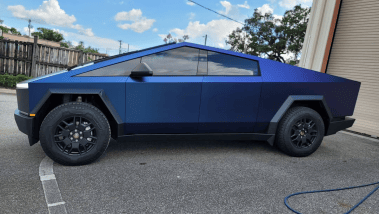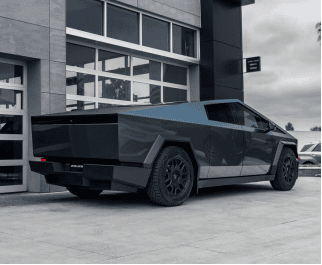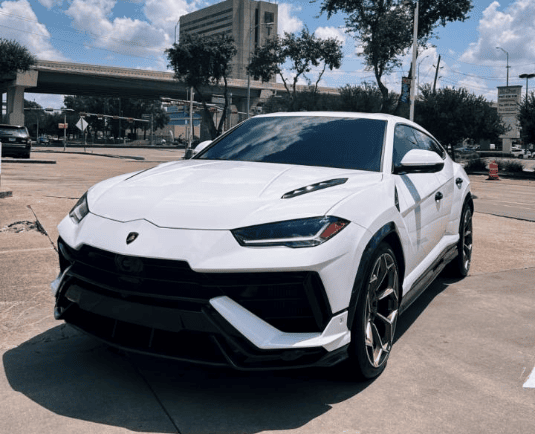Gloss PPF is the classic, high-shine option that enhances the natural gloss of your factory paint. It’s virtually invisible but makes colors pop with a showroom-like finish. Gloss film is the closest match to your car’s original clear coat, making it the most common and widely chosen PPF style.
It’s also the lowest-maintenance finish compared to satin or matte, since it blends seamlessly and hides minor imperfections better. For most owners, gloss PPF is the entry point into paint protection.
Satin PPF sits in the middle ground between glossy and fully matte finishes. It has a low-sheen, silky appearance that enhances the natural curves of your vehicle without being overly flashy. Unlike clear gloss PPF, satin adds a subtle refinement that looks premium and factory-integrated.
Many luxury brands now offer satin paint as an OEM option, but with satin PPF, you get the same look plus the protective benefits of an advanced thermoplastic urethane film. Satin PPF is ideal for drivers who want something distinct without going full stealth mode.
Matte PPF delivers the ultimate stealth look. It eliminates reflections almost completely, giving your car a flat, bold appearance. This is a favorite for modern SUVs, high-performance sports cars, and drivers who want to stand out with a finish that feels aggressive and unique.
Unlike satin, matte PPF requires extra attention in maintenance. Improper washing can leave behind unwanted shine, gloss patches, or even water spots. When done right, though, a matte wrap transforms a car into a statement piece.
Satin vs Matte vs Gloss: Key Appearance Differences
| Gloss PPF | Satin PPF | Matte PPF |
Glossiness | High shine, factory finish | Low-sheen, silky glow | Flat, no reflection |
Style | OEM look, fresh and bright | Refined, elegant, modern | Bold, stealth, aggressive |
Best Fit | Everyday cars, luxury, resale value | Luxury sedans, subtle customization | Sports cars, custom builds |
Maintenance | Easiest | Moderate | Most demanding |


Image 2 Satin Purple & Blue Image 3 Gloss Byron Bay Blue
Installation and Technical Considerations
Installing satin or matte PPF requires more precision than clear gloss film. Any imperfections, stretching, or trapped particles can show more clearly with these finishes.
Professional installation is strongly recommended for both satin and matte. Key considerations include:
- Edge Wrapping: Proper tucking around panels ensures no gloss paint peeks through.
- Lighting Control: Installers must check under multiple light angles to avoid streaks.
- Surface Prep: Paint correction or polishing may be required before film application.
UPPF recommends
certified installers who are trained to handle not just satin and matte, but also clear gloss films like our Nano P20 Clear PPF for optimal results.
Image 4 Clear Gloss Nano P20
Maintenance and Care
Gloss PPF
-Easiest to maintain
-Safe with wax or ceramic sprays
-Wash with pH-neutral soap and microfiber towels
-Light polishing may be needed for swirls
Satin PPF
- Easier to clean than matte.
- Hides fingerprints and light swirls well.
- Avoid high-shine waxes or sealants—these can disrupt the satin finish.
- Use pH-neutral soaps and microfiber towels.
Matte PPF
- More prone to showing water spots and streaks.
- No wax, no polish, no automated brushes—stick to hand washes only.
- Dedicated matte-safe cleaners are highly recommended.
- Always dry with microfiber to prevent spotting.
With the right routine, both satin, gloss and matte films can last up to 10 years. Still, if you want the lowest maintenance option,
clear gloss PPF remains the simplest to care for, as it blends seamlessly with your car’s natural gloss.
The cost of satin and matte PPF varies depending on vehicle size, installer, and film quality. Generally:
- Satin PPF: Slightly more than gloss clear due to finish complexity.
- Matte PPF: Similar pricing, but may come with higher upkeep costs over time.
- Gloss PPF: Still the most common and affordable entry point for paint protection.
A full wrap typically ranges from $4,000 to $8,000, depending on your installer and region. Partial wraps (front bumper, hood, mirrors) are more budget-friendly.
Gloss PPF Pros
-Enhances depth and shine-
Lowest maintenance finish
-Invisible protection that looks factory-new
Gloss PPF Cons
-Common look (less unique than satin or matte)
-Still requires professional installation
-Gloss swirls can show over time
Satin PPF Pros
- Elegant, factory-like look
- Easier upkeep than matte
- Hides swirls and fingerprints well
Satin PPF Cons
- More expensive than clear PPF
- Requires professional installation
Matte PPF Pros
- Bold, aggressive aesthetic
- Creates a truly unique look
- Same protection as clear
Matte PPF Cons
- High maintenance care routine
- Gloss patches if cleaned incorrectly
Which Finish is Right for You?
- Choose Satin PPF if you want a subtle, premium look with manageable upkeep.
- Choose
Matte PPF if you want to make a bold, stealthy statement and don’t mind the extra care.
- Stick with Clear PPF if your priority is invisible protection that keeps your car looking new.
Gloss, Satin and matte PPF both deliver incredible ways to transform your vehicle’s look while preserving its paint. Satin leans toward elegance, matte toward boldness, and gloss PPF toward a shiny, everyday option.
If you’re still unsure, many installers recommend starting with Clear Paint Protection Film to secure your car’s finish first. You can always explore satin or matte down the line for customization.
Whichever you choose, PPF ensures your car stays looking flawless while standing strong against daily road hazards. And with UPPF’s advanced technology, including self-healing, hydrophobic properties, and a 10-year warranty, you get not just protection but long-lasting style confidence.






